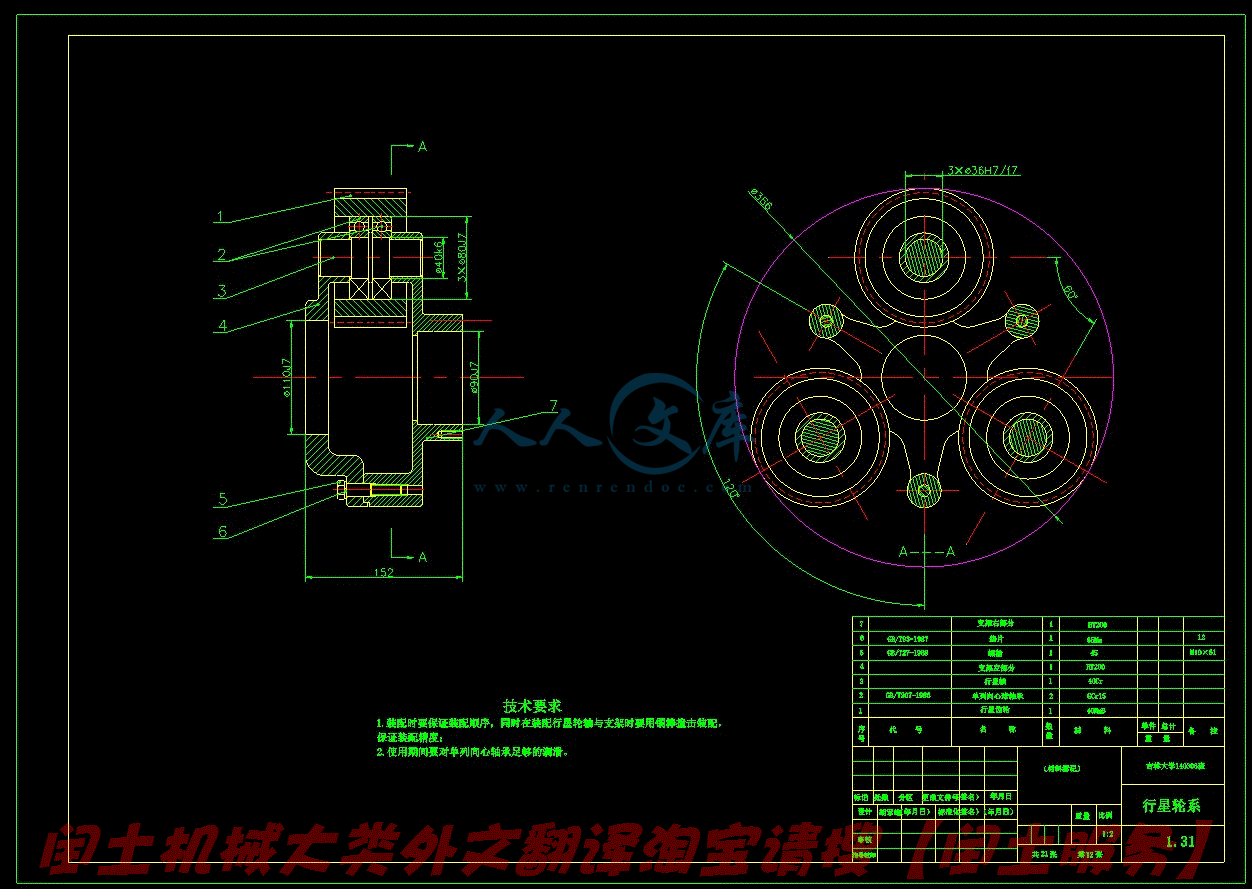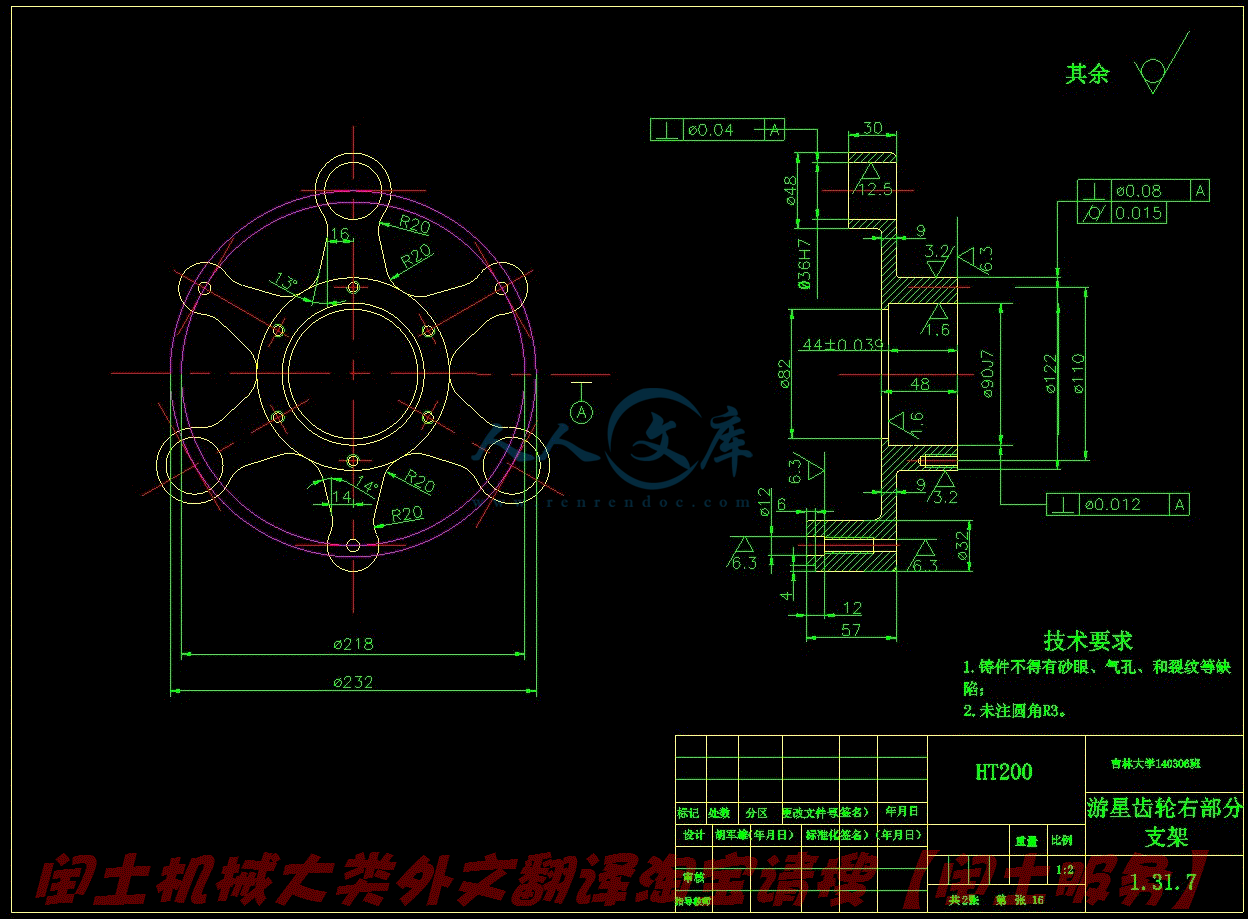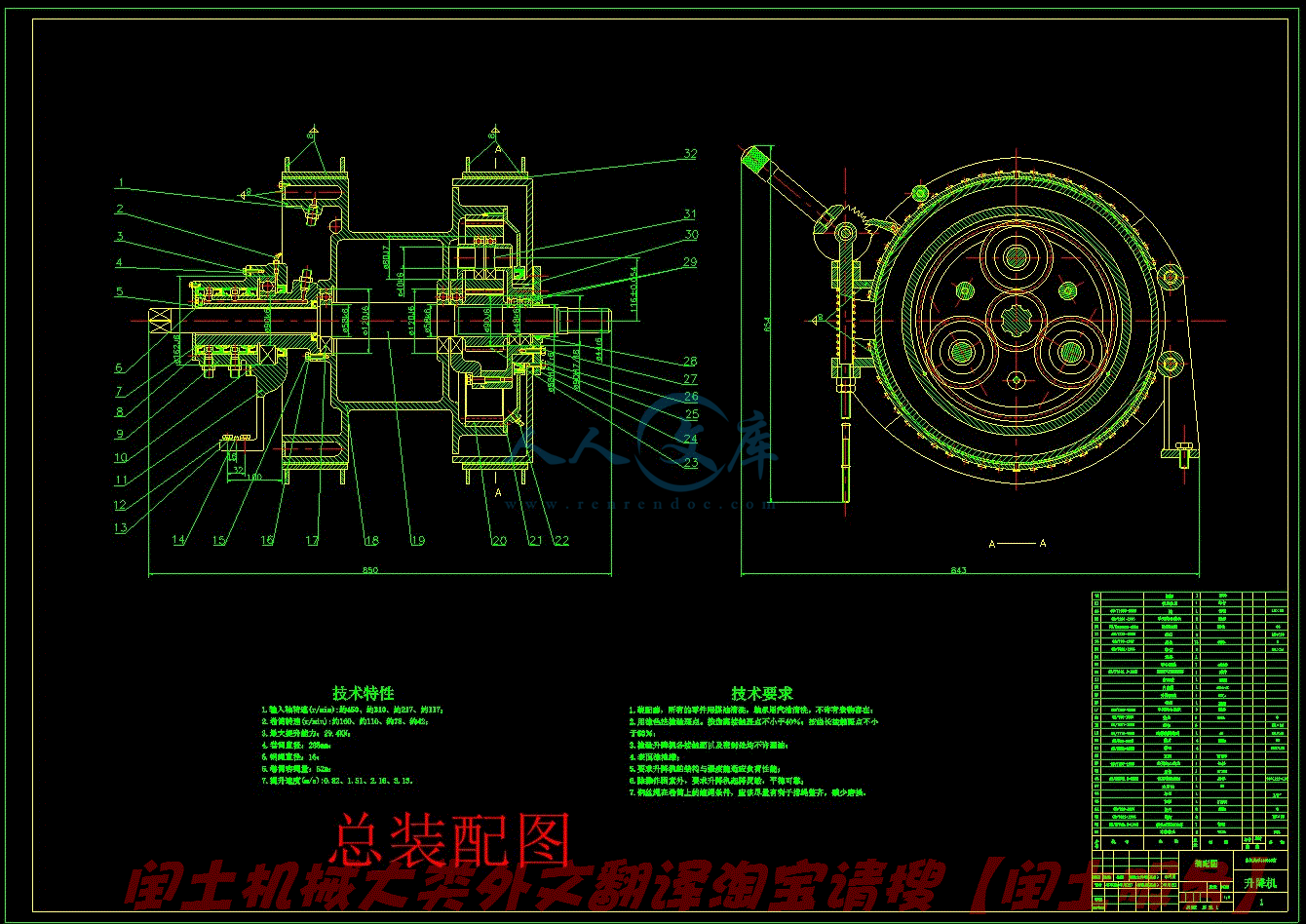资源目录

压缩包内文档预览:(预览前20页/共67页)
编号:6035129
类型:共享资源
大小:6.01MB
格式:RAR
上传时间:2017-10-23
上传人:闰***
认证信息
个人认证
冯**(实名认证)
河南
IP属地:河南
50
积分
- 关 键 词:
-
xy-4
岩心
钻机
升降机
设计
- 资源描述:
-



















- 内容简介:
-
Studies in dynamic design of drilling machine using updated finite element models AbstractThe aim of the present work is to develop updated FE models of a drilling machine using analytical and experimental results. These updated FE models have been used to predict the effect of structural dynamic modifications on vibration characteristics of the drilling machine. Two studies have been carried out on the machine. In the first study, modal tests have been carried out on a drilling machine using instrumented impact hammer. Modal identification has been done using global method of modal identification. For analytical FE modeling of the machine, a computer program has been developed. The results obtained using FEM, have been correlated with the experimental ones using mode shape comparison and MAC values. Analytical FE model has been updated, with the help of a program, which has been developed using direct methods of model updating. In the second study, modal testing has been carried out using random noise generator and modal exciter. Global method has been used for modal identification. Analytical FE modeling has been done using I-DEAS software. Correlation of FE results with the experimental ones has been carried out using FEMtools software. Updating of the analytical FE model has also been done using the above software, based on an indirect technique viz. sensitivity based parameter estimation technique. The updated FE models, obtained from both the studies have been used for structural dynamic modifications (SDM), for the purpose of dynamic design and the results of SDM predictions are seen to be reasonably satisfactory. Article Outline1. Introduction 2. Modal testing and identification 3. Finite element formulation of drilling machine 4. Comparison of analytical FE and experimental results (model correlation) 5. Finite element model updating 6. SDM studies using updated models for dynamic design 7. Conclusions References1. IntroductionDynamic design aims at obtaining desired dynamic characteristics in machines and structures, which may include shifting of natural frequencies, desired mode shapes and vibratory response. The ultimate objectives are to have a quieter and more comfortable environment, higher reliability and better quality of product. The conventional dynamic design is basically hit and trial method in which we try to achieve desired dynamic characteristics by making several prototypes. The disadvantage of this technique is that actual design cycle takes a lot of time and therefore it is not cost effective. However, model updating based dynamic design saves design cycle time as well as reduces the cost involved. Various tools used for updating based dynamic design are: experimental modal analysis (EMA) including modal testing and modal identification, model updating and structural dynamic modification. Ewins 1 and Maia and Silva 2 have explained the basic concepts of modal testing, which is an experimental approach to obtain mathematical model of a structure. In a modal test, the structure under test is excited either by an impact hammer or by a modal exciter, and the response of the structure is recorded at several experimental points, in the form of frequency response functions (FRFs), using a dual channel FFT analyzer. The experimental modal model gives information about the natural frequencies, corresponding mode shapes and modal damping factor and is useful for model updating. The model updating techniques helps us to bring analytical finite element models closer to real systems. In model updating an initial analytical FE model constructed for analyzing the dynamics of a structure is refined or updated using test data measured on actual structure such that the updated model describes the dynamic properties of the structure more correctly. The inaccuracies in FEM, when applied to dynamic problems are due to uncertainties in boundary conditions and structural damping etc. Friswell and Mottershead 3 have discussed the finite element model updating in structural dynamics. Baruch and Bar-Itzhack and Baruch 4 and 5 considered analytical mass matrix to be exact and developed a direct method for updating using test data. Berman and Nagy 6 developed a method of model updating, which uses measured modes and natural frequencies to improve analytical mass and stiffness matrices. Structural dynamic modification (SDM) techniques 7 and 8 are the methods by which dynamic behaviour of the structure is improved by predicting the modified behaviour brought about by adding modifications like those of lumped masses, rigid links, dampers etc. Thus the dynamic design using updated model is expected to be helpful in order to predict accurately and quickly, the effect of possible modifications on the dynamic characteristics of the structure at computer level itself, thus saving time and cost. Sestieri 7 has discussed SDM application to machine tools and engines. Kundra 8 gave the method of structural dynamic modification via models. Modak 9 has discussed SDM predictions using updated FE model for an F-structure. He used constrained nonlinear optimization method for updating of a machine tool using stiffness parameters at the boundary 10. The present paper deals with the FE model updating using direct as well as indirect method, and to use this updated FE model for dynamic design based on SDM predictions of a machine tool viz. a drilling machine. Two different studies are reported using different techniques for analytical and experimental analysis and for updating. Various objectives with which the present research work has been carried out are To develop updated FE models of a complex structure like that of a drilling machine and to use these updated models to predict the effect of various modifications on modal properties of the machine. To see whether hammer excitation yields good results for fairly complex structures like drilling machine or not, and to compare these results with those obtained from modal exciter. To analyze the results of SDM predictions obtained using the updated models derived in the studies.2. Modal testing and identificationIn the two studies mentioned earlier, different techniques have been used, for modal testing and identification. In the first study, impact hammer is used to excite the drilling machine structure, at various points as shown in Fig. 1 and Fig. 2. Response is taken at a fixed point with the help of an accelerometer. Response in the form of FRFs is recorded in the FFT analyzer. (12K) Fig. 1. Experimental setup (Study 1). (4K) Fig. 2. Hammer excitation locations. In the present study, the drilling machine is excited at 30 locations and therefore, 30 FRFs are obtained. These FRFs are recorded in the form of inertance. The experimental FRFs, thus obtained are transferred to computer, for extraction of modal properties i.e. modal identification in ICATS software. Modal identification or modal parameter extraction consists of curve fitting a theoretical expression for an individual FRF to the actual measured data obtained. The experimental FRFs are analyzed by GRF-M method using modal analysis software ICATS 11 to obtain modal parameters of the drilling machine. In the second study, the machine tool structure has been excited at the base at point 28, referring to Fig. 2, using modal exciter and response has been measured at various points using piezoelectric accelerometers. The modal identification of the FRFs, thus measured has been carried out using global method GRF-M method in ICATS software. Table 1 compares the experimental natural frequencies obtained from both the methods, which shows minor differences in the two modal frequencies and MAC values. Table 1. Comparison of analytical and experimental model natural frequencies Mode number Study 1 Study 2 Analytical modelExperimental modelMAC valuesAnalytical modelExperimental modelMAC valuesMode1 10.29 Hz 8.67 HZ 0.953 11.20 Hz 8.79 Hz 0.946Mode 2 65.14 Hz 47.34 HZ 0.901 63.37 Hz 44.40 Hz 0.9063. Finite element formulation of drilling machineSeveral books have given the basic concepts of finite element analysis, some of them are: Zienkiewicz 12 and Bathe 13. The drilling machine structure is very complicated with different mountings and accessories. Therefore exact modeling and analysis of the actual structure is difficult and it takes more computational effort. However for analytical FE analysis, simplified model of drilling machines has been considered. In study 1, the finite element modelling has been done using a program developed in MATLAB. Beam elements have been used for the analysis. The joints and boundary conditions are considered to be rigid and influence of structural damping on modal model parameters, is ignored. The relevant data used for the drilling machine is given below: 25 mm pillar type, height = 1.655 m, mass density = 7800 kg/m3, Youngs modulus = 200 Gpa, number of nodes = 30, number of elements = 29, number of nodes per element = 2, degrees of freedom per node = 3. Fig. 3 shows the structure of the drilling machine with the node numbers given for study 1. (7K) Fig. 3. Drilling machine structure for FE analysis. The eigenvalues and eigenvectors have been calculated from the assembled mass M and stiffness K matrices. The analytical FE model of the structure consists of 90 90-size mass and stiffness matrices (30 3, 30 nodes and 3 d.o.f. per node). But by experiment only 30 coordinates can be measured. Therefore FE model has been reduced using Guyan 14 reduction method with the help of a program developed in MATLAB. In study 2, the finite element modelling has been done using I-DEAS software. The model has been made using beam mesh. Although the FE model has been simplified but the beam elements has rotational degree of freedom, which cannot be measured experimentally. Therefore the FE model needs to be reduced. The FE model has been reduced using model reduction utility in FEMtools software. Fig. 4 and Fig. 5 shows the mode shape animation for the first and second mode respectively, using I-DEAS software. (31K) Fig. 4. Mode shape animation (first mode). (23K) Fig. 5. Mode shape animation (second mode). Table 1 compares the analytical FE natural frequencies obtained from both the methods, with some differences in the two cases. 4. Comparison of analytical FE and experimental results (model correlation)The first stage of any reconciliation exercise is to determine how closely the experimental and analytical models correspond. If we are unable to obtain a satisfactory degree of correlation between the initial analytical FE model and the test data, then it is extremely unlikely that any form of model updating will succeed. Thus, a successful correlation is crucial for the success of model updating. Table 1 gives the comparison between experimental and analytical natural frequencies, for the first two modes, obtained from both the studies. There are differences between analytical FE model predictions and experimental results, which is due to assumptions and approximations involved in the FE model. Thus the FE models need to be updated. However, the differences between the corresponding results of both studies are minor. Apart from natural frequency comparison (as given in Table 1), another method of model correlation is mode shape comparison. To compare the mode shapes, we plot the deformed shapes of the structure for a particular mode, using experimental as well as analytical model. These mode shapes are plotted side-by-side for quick comparison. This is a graphical approach to model correlation. Mode shape corresponding to second mode is shown in Fig. 6, using ICATS software. It shows a fairly good level of correlation between the experimental and analytical FE model. (87K) Fig. 6. Mode shape comparison. Several researchers have developed techniques for quantifying the comparison between measured and predicted mode shapes. As an alternative to the graphical approach, Model Assurance Criterion i.e. MAC, 15) is a widely used technique to estimate the degree of correlation between mode shape vectors. This provides a measure of the least squares deviation or scatter of the points from the straight-line correlation. The MAC between a measured and analytical mode is:(1)where m and a represents measured or experimental and analytical mode shapes respectively. MAC is a scalar quantity whose value is between 0 and 1. A value of MAC close to 1 shows a good degree of correlation between experimental and analytical FE model. We can see in Table 1 that the MAC numbers are close to 1, though somewhat lower for the second mode. Table 1 also shows that the results obtained from both the studies are quite close to each other. 5. Finite element model updatingModel updating can be defined as “the process of correcting the numerical values of individual parameters in a analytical FE model using data obtained from an associated experimental model such that the updated model correctly describes the dynamic properties of the subject structure”. Various model updating methods can be classified into two major groups: Direct matrix methods Indirect or iterative methodsDirect methods are capable of reproducing measured data exactly, but they provide no opportunity for the user to select parameters for updating. Here parameter means any physically realizable quantity like Youngs modulus, Poissons ratio, mass density etc. When using the direct methods, the entire stiffness and mass matrices are updated in a single (non-iterative) solution step. Then, the individual matrix terms all get changed without any regard for the change in element shape or size. Consequently any physical meaning, which the initial finite element model might have possessed, is lost in the updating process. Techniques like the indirect methods, allow the updating parameters to be selected. So, considerable physical insight is required if the model is to be improved, not only in its ability to reproduce test results, but also in interpreting the parameters physically. Methods in this second group are iterative and, as such, considerably more expensive of computer effort. Two studies have been carried out for model updating and computer programs for the same were developed in the present work using MATLAB. In the first study, two direct methods are applied to update the analytical FE model of the drilling machine structure. Baruch and Bar-ltzhack 4 and Baruch 5 considered the mass matrix of the analytical model to be exact. The measured eigenvectors are corrected by using the relation:(2)The stiffness matrices of the analytical FE model after updating is given as:Ku=Ka-Ka TMa+Ma TKa+Ma TKa TMa+Ma TMa (3)The derivation is based on the corrected stiffness matrix and should reproduce the measured modal data. Berman and Nagy 6 used a method similar to that of Baruch. They update mass and stiffness matrices while the mass matrix is updated to ensure the orthogonality of the exact FE model modes. The mass matrix is updated as:(4)(5)The stiffness matrix is updated using following equation:(6)Eqs. Figs. (3) and (6) are identical. The updated mass matrix obtained will be symmetric and stiffness matrix will be close to that of exact stiffness matrix. Results obtained from Baruch and BermanNagy model updating methods are tabulated in Table 2. It is clear from Table 2, that the updated model reproduces the measured frequencies. After updating, MAC values have been calculated again using Eq. (1) and are shown in Table 2. It can be observed that updated MAC values show some improvement over the initial MAC values. Table 2. Comparison of experimental and updated FE frequencies and MAC values Mode number Study 1 Study 2 Measured frequency Baruch method Berman method Measured frequencySensitivity method Updated frequency MACUpdated frequency MACUpdated frequency MACMode 1 8.67 Hz 8.67 Hz0.925 8.67 Hz0.934 8.79 Hz 8.79 Hz0.947Mode 2 47.34 Hz 47.34 Hz0.966 47.34 Hz0.947 44.40 Hz 44.43 Hz0.913In the second study, the model updating of drilling machine has been carried out using indirect or modal sensitivity method. Modal sensitivity for the selected parameters has been found out using FEMtools software. FEMtools software uses Bayesian parameter estimation 16 technique, which is an iterative method of model updating, and it is sensitivity based parameter estimation technique. The FE model has been updated using sensitivity method. The various parameters selected for updating are: Youngs modulus of elasticity Mass density Cross section area Bending moment of inertiaThe normalised sensitivity has been calculated for the above parameters for both the modes using the above software. With the updating parameters, the model-updating program has been executed for five iteration, with a maximum of 1% variation in the weighted absolute relative difference (CCABSOLUTE) between resonance frequencies. The results after updating have been tabulated in Table 2. It clearly shows that after updating, the updated FE model closely represents the actual machine tool structure. It also shows that MAC values have also been improved after updating. Table 2 also shows that the updated frequencies for both the cases are quite close to each other for the first mode. 6. SDM studies using updated models for dynamic designStructural dynamic modification (SDM) techniques are methods by which dynamic characteristics of the structure can be improved by adding the modifications like changing mass, spring, damping etc. The mass modification has been considered here for predicting dynamic characteristics using updated FE model. A mass modification on drilling machine is introduced in the form of a lumped mass of 14.3 kg at the top of the vertical pillar, i.e. node 20 as in Fig. 3. The drilling machine is shown schematically in Fig. 7. The modal test for
- 温馨提示:
1: 本站所有资源如无特殊说明,都需要本地电脑安装OFFICE2007和PDF阅读器。图纸软件为CAD,CAXA,PROE,UG,SolidWorks等.压缩文件请下载最新的WinRAR软件解压。
2: 本站的文档不包含任何第三方提供的附件图纸等,如果需要附件,请联系上传者。文件的所有权益归上传用户所有。
3.本站RAR压缩包中若带图纸,网页内容里面会有图纸预览,若没有图纸预览就没有图纸。
4. 未经权益所有人同意不得将文件中的内容挪作商业或盈利用途。
5. 人人文库网仅提供信息存储空间,仅对用户上传内容的表现方式做保护处理,对用户上传分享的文档内容本身不做任何修改或编辑,并不能对任何下载内容负责。
6. 下载文件中如有侵权或不适当内容,请与我们联系,我们立即纠正。
7. 本站不保证下载资源的准确性、安全性和完整性, 同时也不承担用户因使用这些下载资源对自己和他人造成任何形式的伤害或损失。

人人文库网所有资源均是用户自行上传分享,仅供网友学习交流,未经上传用户书面授权,请勿作他用。
 川公网安备: 51019002004831号
川公网安备: 51019002004831号